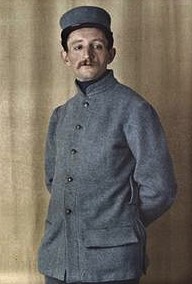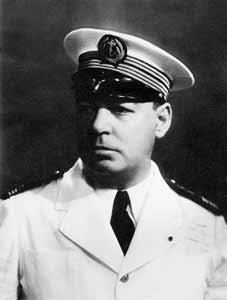Author’s note: This story is just one from a series that look at World War I and WWI General John J. Pershing. Click here to see more of the series.- Bernard R. McCoy)
After the war’s end in 1918, an extraordinary film was commissioned by the French government to capture the scale of the Great War’s devastation and the shocking extent of the fighting across the Western Front in northern France and Belgium.

Lucien Le Saint, 1917, © Musée Albert-Kahn – Département des Hauts-de-Seine
The 78-minute film was called “En dirigeable sur les champs de bataille” (“In airship on the battlefield”). It was shot by film-maker Lucien Le Saint in what was said to be a French government effort to obtain reparations from the Germans for the devastation left behind by the war.
The film was shot at the beginning of 1919 with French balloon pilot Jacques Trolley de Prévaux as he flew a few hundred feet above the battleground.

Jacques Trolley de Prévaux Photo: French government
Thanks to the French government, I was able to get portions of the film and have paired them in the video below with a portion of the song ‘The Awakening’ by composer Joseph M Martin.
To me, the song’s lyrics capture the physical and spiritual desolation left behind in the war’s ruins.
“I dreamed a dream, a silent dream of a land not far away.
Where no bird sang, no steeples rang, and teardrops fell like rain.
I dreamed a dream; a silent dream. I dreamed a dream of a land so filled with pride that every song, both weak and strong, withered and died.
I dreamed a dream.
No hallelujah; not one hosanna! No song of love, no lullaby.
And no choir sang to change the world. No pipers played, no dancers twirled.
I dreamed a dream; a silent dream.”
A naval gunnery officer before the war started in 1914, Jacques Trolley de Prévaux had been retrained to fly the dirigibles that had been developed to spot for artillery, detect mines at sea and fight against submarines. For his actions he was awarded the Légion d’honneur and the Croix de guerre.
He joined the French Resistance at the beginning of 1942 and turned down an opportunity to go to London, but decided to stay in France. According to the French government’s Chemins de Mémoire, Trolley de Prévaux felt he would be of more use at home than in London. Secondly, his wife, a Jew of Polish origin and a resistance fighter along with him, was pregnant.

Jacques and Lotka Trolley de Prévaux in 1936. Photo: Paris Match
In the spring of 1943, he received the Distinguished Service Order from the British and appointed to become one of the main leaders of the French Resistance. He was arrested by the Gestapo in Marseille in March 1944. Jailed at Montluc Prison, he was executed in August 1944. His wife, Lotka, met with the same fate. Promoted to the rank of Rear Admiral, Trolley de Prévaux was posthumously made a Compagnon de la Libération, or Hero of the Liberation of France.
